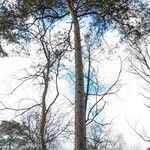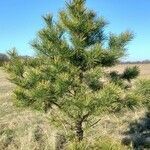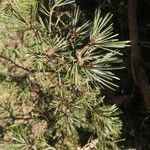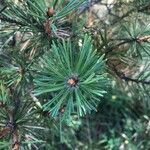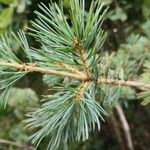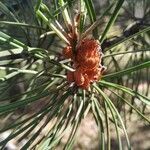An evergreen tree. It grows 15-30 m high and spreads 7.5-9 m wide. The young bark is reddish-brown. It develops a tall clean trunk. The leaves are twisted in pairs. They are grey or blue-green. The needles are 3-14 cm long by 1-2 mm wide. They are stiff and have a sharp point. The edges have fine teeth. Male flowers grow at the base of the shoot. Crimson female flowers are in pairs at the end of the current year's growth. The cones are green and ripen to pale grey or red-brown. They are 8 cm long. They often occur in clusters of 2 or 3. They point back along the stem. The seed are released slowly during winter and the following spring. The seeds are very dark brown and 2-4 mm long. The seed cone scales are 4 sided and raised. Some varieties have been described based on the colour of the winter buds and the thickness of the needles.
Trees to 40 m tall; bark red-brown, flaking; branchlets dark gray-brown; winter buds red-brown or pale to yellowish brown, ovoid to oblong-ovoid, resinous. Needles 2 per bundle, blue-green, semiorbicular in cross section, (0.5-)3-14 cm × 1-2 mm, stiff, stomatal lines present on all surfaces, vascular bundles 2, resin canals 6-8, marginal, base usually twisted, with persistent sheath. Seed cones dull yellow-brown at maturity, conical-ovoid, 3-6 cm. Apophyses broadly rhombic, flat or shortly pyramidal; umbo small, blunt or mucronate.
Tree to 30 m; bark of the larger branches and a segment of the main trunk conspicuously orange-brown and appearing blistered; lvs in 2’s, bluish-green, usually twisted, 3–7 cm × ca 1.5 mm; cones yellow-brown, soon reflexed, short-ovoid to oblong, often bent, 3–6 cm, the apophysis thickened, the umbo scarcely elevated, spineless. Native of Europe, occasionally escaped from cult. in our range.
Varieties ca. 20 (1 introduced in the flora): North America, Eurasia.
